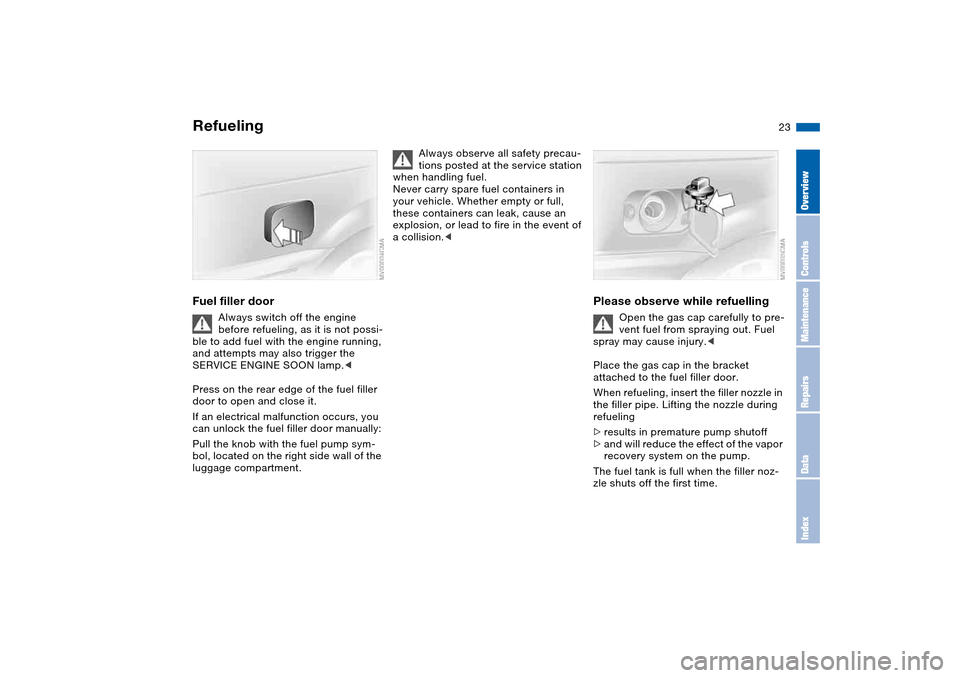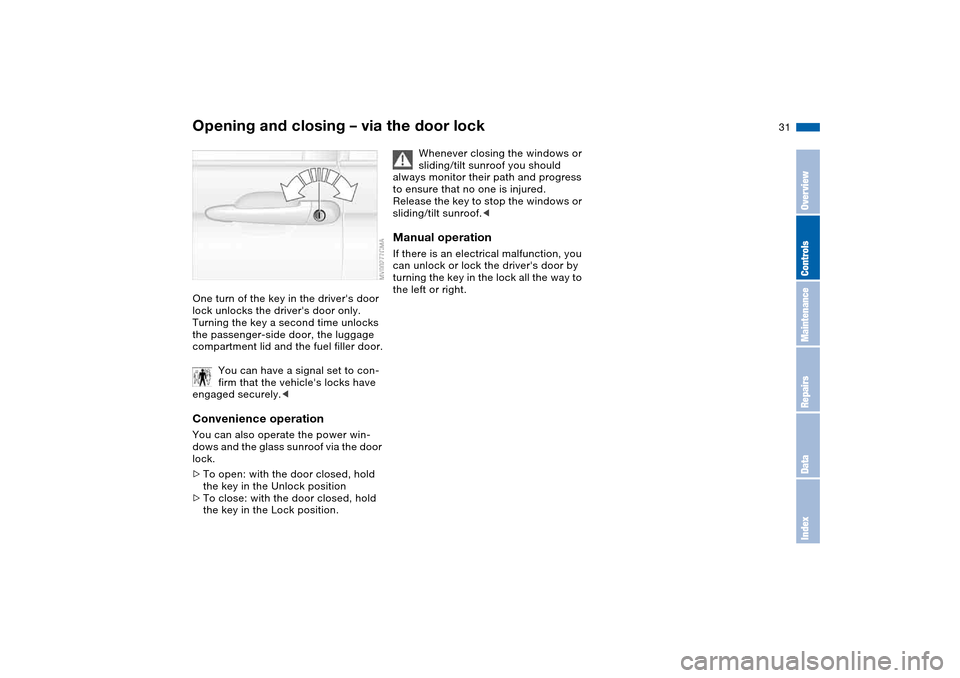2004 BMW 325CI COUPE fuel
[x] Cancel search: fuelPage 8 of 174

Contents
Notes
About this Owner's Manual4
Additional sources of
information4
Symbols used4
Your individual vehicle5
Status at time of printing5
For your own safety5
Service and warranty6
Reporting safety defects7
Overview
Cockpit14
Instrument cluster16
Indicator and warning lamps18
Buttons in steering wheel*21
Hazard warning triangle*22
First-aid kit*22
Refueling23
Fuel specifications24
Controls and features
Opening and closing:
Keys28
Central locking system28
Opening and closing – via the
remote control29
Opening and closing – via the
door lock31
Opening and closing – from the
inside32
Luggage compartment lid33
Luggage compartment35
Alarm system*36
Electric power windows38
Glass sunroof, electric*39
Adjustments:
Safe seating position41
Seats42
Manual seat adjustment42
Power seat adjustment*44
Lumbar support*44
Head restraints45
Entering the rear45
Safety belts46
Seat and mirror memory*47
Seat heating*48
Mirrors49
Steering wheel50
Page 9 of 174

Contents
9
Passenger safety systems:
Airbags51
Transporting children safely54
Vehicle Memory, Key
Memory58
Driving:
Ignition lock59
Starting the engine59
Switching off the engine61
Parking brake61
Manual transmission62
Sequential manual gearbox
SMG*63
Automatic transmission with
Steptronic*67
Turn signal indicator/Headlamp
flasher70
Washer/wiper system/Rain
sensor*71
Cruise control*72
Everything under control:
Odometer74
Tachometer74
Energy control74
Fuel gauge75
Engine coolant temperature
gauge75
Service interval display76
Check Control76
Clock77
Computer78
Technology for safety and
driving convenience:
Park Distance Control (PDC)*80
Dynamic Stability Control
(DSC)81
Flat Tire Monitor*82
Brake force display84
Lamps:
Parking lamps/Low beams85
Adaptive headlights*86
Instrument lighting86
High beams/Standing lamps87
Front fog lamps87
Interior lamps88
Controlling the climate for
pleasant driving:
Air conditioning90
Automatic climate control*94
Roller sun blind*98
Interior conveniences:
Premium sound system*99
Glove compartment99
Storage compartments100
Microphone*101
Ashtray, front*102
Ashtray, rear*102
Clothes hooks103
Loading and transporting:
Through-loading system104
Ski bag*105
Cargo loading106
Roof-mounted luggage
rack*109
Controls and features
Page 17 of 174

17
1Fuel gauge75
2Indicator lamp for turn signals20
3Speedometer
4Indicator and warning lamps18
to20
5Tachometer and Energy Control74
6Engine coolant temperature
gauge75
7Indicator and warning lamps18
to20
8Control button for the clock77
9Selector lever and program display
for automatic transmission/sequen-
tial manual gearbox SMG, transmis-
sion indicator lamp19, 65, 69
10 Display for
>
Trip odometer/Odometer74
>
Clock77
>
Service interval76
>
Computer78
11 Check Control76
12 Trip odometer, reset to zero74
13 Indicator and warning lamps18
to20
Instrument cluster
OverviewControlsMaintenanceRepairsDataIndex
Page 19 of 174

19
Brake warning lamp for Cana-
dian models.
Please fasten safety belts
●
Comes on together with an
acoustic signal until the safety
belts are fastened.
For additional information on safety
belts, refer to page 46.
Airbags
●
Have the system checked as
soon as possible.
For additional information, refer to
page 53.
Orange: consult the nearest BMW
center
Automatic transmission/sequen-
tial manual gearbox
The respective transmission has
responded to a malfunction by reverting
to operation in its emergency default
program. Have the system checked
immediately.
For additional information, refer to
pages 65, 69.
Yellow: check as soon as possible
Engine oil level
If the lamp comes on during
normal vehicle operation: the
engine oil level has fallen to the abso-
lute minimum; refill as soon as possible.
Do not drive more than approx.
30 miles/50 km before refilling.
For additional information, refer to
page 126.
Engine oil level
Comes on after the engine has
been shut off: add engine oil at
the earliest opportunity, such as the
next time you stop to refuel.
For additional information, refer to
page 126.
Brake pads
●
Have the brake pads checked
immediately.
For additional information, refer to
page 114.
Flat Tire Monitor
●
The Flat Tire Monitor is malfunc-
tioning or out of order. If there is
a malfunction, have the system
checked.
For additional information, refer to
page 84.
Dynamic Stability Control
(DSC)
●
Indicator lamp flashes:
The system is actively regulating drive
torque and braking force.
The indicator lamp stays lit:
DSC has been switched off with the
button; DTC is operational.
If there is a malfunction, have the sys-
tem checked.
Additional information beginning on 81.
Dynamic Stability Control (DSC)
and brake warning lamp
The indicator lamps remain on:
DSC/DTC have been switched
off with the button or are faulty.
If there is a malfunction, have
the system checked as soon as possi-
ble.
Additional information beginning on 81.
DSC indicator and brake warn-
ing lamps for Canadian models.
Indicator and warning lamps
OverviewControlsMaintenanceRepairsDataIndex
Page 23 of 174

23
RefuelingFuel filler door
Always switch off the engine
before refueling, as it is not possi-
ble to add fuel with the engine running,
and attempts may also trigger the
SERVICE ENGINE SOON lamp.<
Press on the rear edge of the fuel filler
door to open and close it.
If an electrical malfunction occurs, you
can unlock the fuel filler door manually:
Pull the knob with the fuel pump sym-
bol, located on the right side wall of the
luggage compartment.
Always observe all safety precau-
tions posted at the service station
when handling fuel.
Never carry spare fuel containers in
your vehicle. Whether empty or full,
these containers can leak, cause an
explosion, or lead to fire in the event of
a collision.<
Please observe while refuelling
Open the gas cap carefully to pre-
vent fuel from spraying out. Fuel
spray may cause injury.<
Place the gas cap in the bracket
attached to the fuel filler door.
When refueling, insert the filler nozzle in
the filler pipe. Lifting the nozzle during
refueling
>results in premature pump shutoff
>and will reduce the effect of the vapor
recovery system on the pump.
The fuel tank is full when the filler noz-
zle shuts off the first time.
OverviewControlsMaintenanceRepairsDataIndex
Page 24 of 174

24
Closing the gas capPlace the cap in position and turn it
until a clearly audible click is heard.
Close the gas cap carefully after
refueling until a click is heard.
While closing, be sure not to squeeze
the strap which is fastened to the cap.
A loose or missing cap will activate the
CHECK GAS CAP* lamp.<
Warning lamp* lights up. The
gas cap is not properly closed
or is missing. Check if the gas
cap is properly closed.Fuel tank capacity >Approx. 16.6 gal./63 liters, of which
>approx. 2.1 gal./8 liters are reserve
capacity.
Do not drive to the last drop of
fuel. This can prevent the engine
from operating properly and result in
damage.<
Fuel specificationsThe engine uses lead-free gasoline
only.Required fuelPremium Unleaded Gasoline,
Minimum Octane Rating: AKI 91.
Minimum Octane Rating corresponds to
the Anti Knock Index AKI and is deter-
mined according to the so-called
(R+M)/2 method.
Do not use leaded gasoline, as
otherwise the lambda probe and
catalytic converter will be permanently
damaged.
cant differences in fuel quality: volatility,
composition, additives, etc., among
gasolines offered for sale in the United
States and Canada. Fuels containing up
to and including 10 % ethanol or other
oxygenates with up to 2.8 % oxygen by
weight, that is, 15 % MTBE or 3 % meth-
anol plus an equivalent amount of co-
solvent, will not void the applicable
warranties with respect to defects in
materials or workmanship.
The use of poor-quality fuels may
result in drivability, starting and
stalling problems especially under cer-
tain environmental conditions such as
high ambient temperature and high alti-
tude.
Should you encounter drivability prob-
lems which you suspect could be
related to the fuel you are using, we
recommend that you respond by
switching to a recognized high-quality
brand.
Failure to comply with these recom-
mendations may also result in unsched-
uled maintenance.<
Refueling
Page 28 of 174

28Opening and closing
KeysThe key set1Master keys with remote control.
They govern the functions of the Key
Memory. Certain functions in your
vehicle may operate differently
depending on the key, refer to
page 58.
To distinguish between keys, you can
mark each key with remote control by
applying one of the colored decals
that you received when accepting
delivery of your vehicle
In every master key with the
remote control feature there is an
extended-life battery that is charged
automatically in the ignition lock as you
drive.
Therefore, use otherwise unused mas-
ter keys for a longer journey every six
months so that the battery can be
charged.<
2Spare key – for storage in a safe
place, such as in your wallet. This key
is not intended for constant use. The
luggage compartment lid and the
glove compartment cannot be locked
and unlocked with this key. This is
useful for valet parking, for example
Central locking systemThe conceptThe central locking system is ready for
operation whenever the driver's door is
closed. The system simultaneously
engages and releases the locks on the
>doors
>luggage compartment lid
>fuel filler door.
The central locking system can be
operated
>from outside via the remote control
as well as via the driver's door lock
>from inside by pressing a button.
The fuel filler door is not locked when
the central locking system is activated
from the inside, refer to page 32. When
the system is actuated from the out-
side, the anti-theft system is also acti-
vated. This prevents the doors from
being unlocked via the lock buttons or
the release handle. The alarm system is
also activated or deactivated.
If locked from the inside, the central
locking system unlocks automatically in
the event of an accident, except on
doors that have been locked individu-
ally using the lock buttons, refer to
page 32. In addition, the hazard warn-
ing flashers and interior lamps come on.
Page 31 of 174

31
Opening and closing – via the door lockOne turn of the key in the driver's door
lock unlocks the driver's door only.
Turning the key a second time unlocks
the passenger-side door, the luggage
compartment lid and the fuel filler door.
You can have a signal set to con-
firm that the vehicle's locks have
engaged securely.
lock.
>To open: with the door closed, hold
the key in the Unlock position
>To close: with the door closed, hold
the key in the Lock position.
Whenever closing the windows or
sliding/tilt sunroof you should
always monitor their path and progress
to ensure that no one is injured.
Release the key to stop the windows or
sliding/tilt sunroof.<
Manual operationIf there is an electrical malfunction, you
can unlock or lock the driver's door by
turning the key in the lock all the way to
the left or right.
OverviewControlsMaintenanceRepairsDataIndex